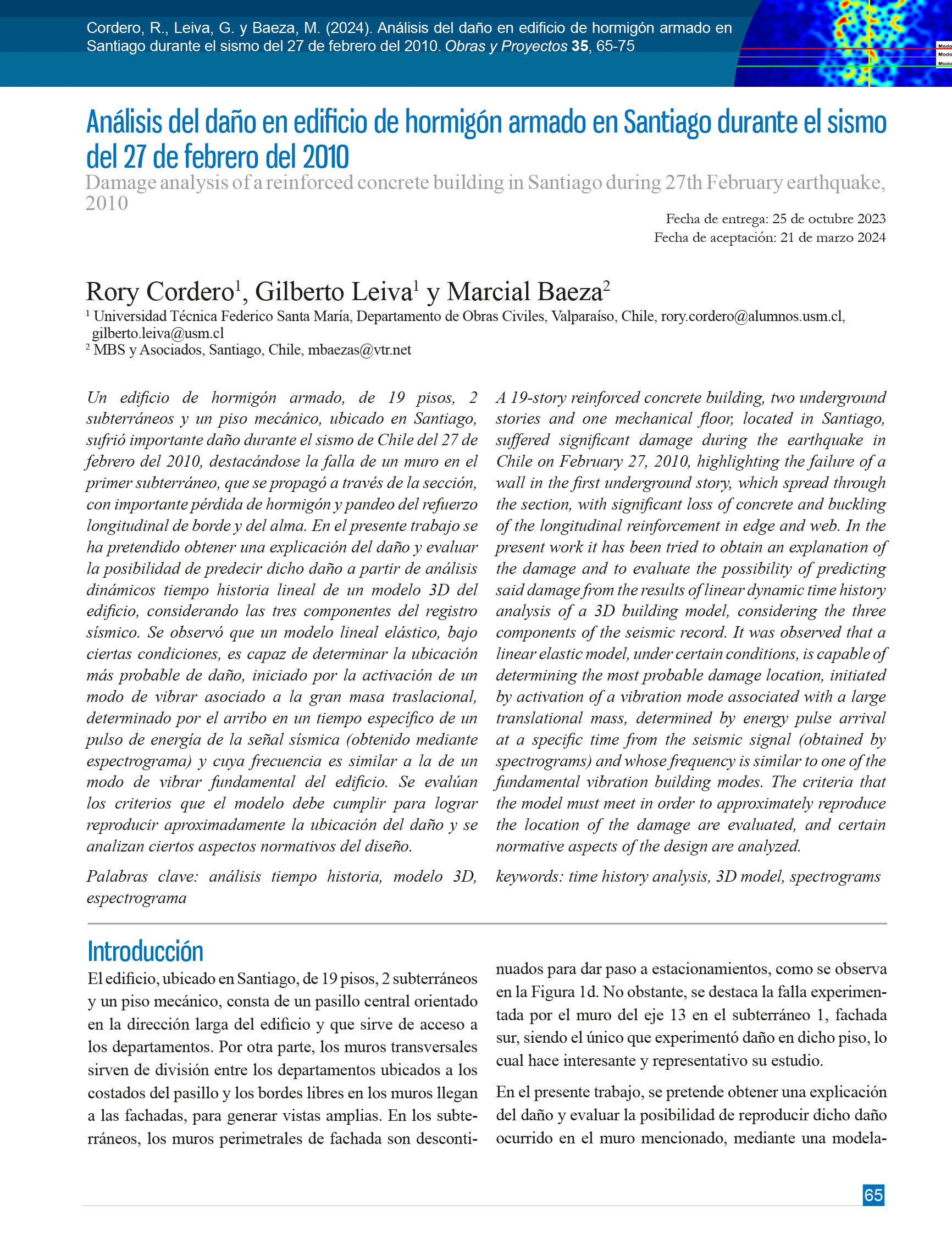Análisis del daño en edificio de hormigón armado en Santiago durante el sismo del 27 de febrero del 2010
DOI:
https://doi.org/10.21703/0718-2813.2024.35.2801Palabras clave:
Análisis tiempo historia, Modelo 3D, EspectrogramaResumen
Un edificio de hormigón armado, de 19 pisos, 2 subterráneos y un piso mecánico, ubicado en Santiago, sufrió importante daño durante el sismo de Chile del 27 de febrero del 2010, destacándose la falla de un muro en el primer subterráneo, que se propagó a través de la sección, con importante pérdida de hormigón y pandeo del refuerzo longitudinal de borde y del alma. En el presente trabajo se ha pretendido obtener una explicación del daño y evaluar la posibilidad de predecir dicho daño a partir de análisis dinámicos tiempo historia lineal de un modelo 3D del edificio, considerando las tres componentes del registro sísmico. Se observó que un modelo lineal elástico, bajo ciertas condiciones, es capaz de determinar la ubicación más probable de daño, iniciado por la activación de un modo de vibrar asociado a la gran masa traslacional, determinado por el arribo en un tiempo específico de un pulso de energía de la señal sísmica (obtenido mediante espectrograma) y cuya frecuencia es similar a la de un modo de vibrar fundamental del edificio. Se evalúan los criterios que el modelo debe cumplir para lograr reproducir aproximadamente la ubicación del daño y se analizan ciertos aspectos normativos del diseño.
Referencias
ACI318 (1999, 2008). Building code requirements for structural concrete and commentary. American Concrete Institute, Farmington Hills MI, USA.
CSI (2012). Integrated finite element analysis and design of structures. SAP2000 v15.1.0. Computers and Structures Inc., Berkeley CA, USA.
CSI knowledge database. (2012). Ritz vs. Eigen vectors: Why are Ritz vectors recommended for dynamic analysis?. Computer and Structures Inc. https://wiki.csiamerica.com/display/etabs/Ritz+vs.+Eigen+vectors [Consulta: 15 Octubtre 2014].
DS60 (2011). Aprueba reglamento que fija los requisitos de diseño y cálculo para el hormigón armado y deroga DS118 de 2010. Ministerio de Vivienda y Urbanismo, Santiago, Chile.
DS61 (2011). Aprueba reglamento que fija el diseño sismico de edificios y deroga DS117 de 2010. Ministerio de Vivienda y Urbanismo, Santiago, Chile.
Harichandran, R.S. (1999). Spatial variation of earthquake ground motion - what is it, how do we model it, and what are its engineering implications?. Michigan State University, USA.
IBC (2012). International building code. International Code Council. USA.
Johnson, P.W. (2008). P-M Characteristics of reinforced concrete sections. MSc thesis, Clemson University, South Carolina, USA.
Lüders, C. (1989). La ductilidad en el comportamiento sísmico de las estructuras. Homenaje a Rodrigo Flores Álvarez. Anales de la Universidad de Chile 21, 411-429.
Marillanca, A. y Leiva, G. (1998). ANSEC - análisis seccional. Departamento de Obras Civiles, UTFSM, Valparaíso, Chile.
Moehle, J. (2015). Seismic design of reinforced concrete building. McGraw Hill, New York, USA
NCh433 (2009). Diseño sísmico de edificios. Instituto Nacional de Normalización INN, Santiago, Chile.
Paulay, T. and Priestley, M.J.N. (1992). Seismic design of reinforced concrete and masonry buildings. John Wiley & Sons, New York, USA.
RENADIC (2012). Red de cobertura nacional de acelerógrafos. http://www.terremotosuchile.cl (consulta 5 julio 2018).
Restrepo, J.I. (1992). Seismic behaviour of connections between precast concrete elements. PhD thesis, University of Canterbury, New Zealand.
Saragoni, S. y Ruiz, S. (2012). Implicaciones y nuevos desafíos de diseño sísmico de los acelerogramas del terremoto del 2010. Cap. 6 en Mw = 8.8 terremoto en Chile 27 de febrero 2010. Universidad de Chile, Santiago, 127-146.
SEAOC (1999). Recommended lateral force requirements and commentary. Structural Engineers Association of California, USA.
The MathWorks Inc. (2014). MATLAB R2014a.
UBC (1994, 1997). Uniform building code. International Conference of Building Officials. Whittier, California, USA.
Wallace, J.W. and Orakcal, K. (2002). ACI 318-99 provisions for seismic design of structural walls. ACI Structural Journal 99(4), 499-508.

Descargas
Publicado
Número
Sección
Licencia

Esta obra está bajo una licencia internacional Creative Commons Atribución-NoComercial 4.0.







